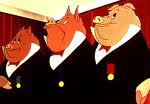Commentary:
This section is concerned with the differences between the book and films texts as regards the pigeons, Orwell used pigeons to represent Soviet propaganda abroad. In the book there is mention of the pigeons causing some animals to rebel. However in the film unlike in the book we also get scenes of a contented cat and a happy lamb. The CIA or OPC investors wanted a heavily changed sequence in the film to make it clear that not all the animals had reason to be unhappy, so there are scenes with a contented cat and a happy lamb. The investors wanted a contrast between good and bad farmers. The reason for this is that the investors hoped people would interpret the good farmers as the United States and its Western allies and the bad farmers as dictators such as Hitler and Stalin. In the book Orwell gives us no good farmers, though he does describe the farmer Pilkington as an easy-going gentleman farmer on page 24, he also says his farm was neglected.
Animal Farm: Film 1955: Pigeons sequence: Please see post.
Animal Farm: Book Text: Pages 24 and 25:
Every day Snowball and Napoleon sent out flights of pigeons whose instructions were to mingle with the animals on neighbouring farms, tell them the story of the Rebellion, and teach them the tune of ‘Beasts of England’. ... Rumours of a wonderful farm, where the human beings had been turned out and the animals managed their own affairs, continued to circulate in vague and distorted forms, and throughout the year a wave of rebelliousness ran through the countryside. Bulls which had always been tractable suddenly turned savage, sheep broke down hedges and devoured the clover, cows kicked the pail over, hunters refused their fences and shot their riders on to the other side. Above all, the tune and even the words of ‘Beasts of England’ were known everywhere.
